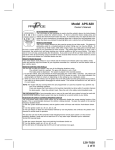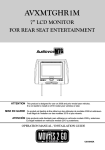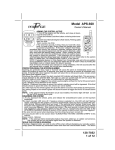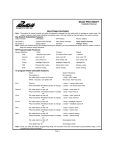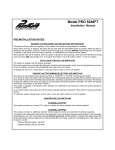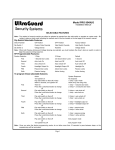Download Mercedes-Benz 2003 SL 55 AMG Automobile User Manual
Transcript
Model/Modèle/Modelo AA-939 REMOTE CONTROL AUTO SECURITY SYSTEM WITH STARTER INTERRUPT, PARKING LIGHT FLASH AND BUILT IN 2 STAGE SHOCK SENSOR SYSTÈME ANTIVOL À TÉLÉCOMMANDE AVEC BLOCAGE DU DÉMARREUR, CLIGNOTEMENT DES FEUX DE POSITION ET DÉTECTEUR D'IMPACT À 2 NIVEAUX INTÉGRÉ SISTEMA DE SEGURIDAD PARA AUTOMÓVILES A CONTROL REMOTO, CON DESACTIVACIÓN DEL ARRANCADOR, DESTELLO DE LUCES DE ESTACIONAMIENTO Y DETECTOR DE CHOQUE INCORPORADO DE 2 ETAPAS INSTALLATION GUIDE & OWNER’S MANUAL GUIDE D'INSTALLATION ET MANUEL D'UTILISATION GUÍA DE INSTALACIÓN Y MANUAL DEL USUARIO This device complies with part 15 of the FCC rules. Operation is subject to the following two conditions; (1) This device may not cause harmful interference, and (2) This device must accept any interference received, including interference that may cause undesired operation. Ce dispositif est conforme à la partie 15 du Règlement de la FCC. L'utilisation est soumise aux deux conditions suivantes : (1) Ce dispositif ne doit pas émettre de brouillage nuisible et (2) il doit accepter toute interférence reçue, y compris celles susceptibles de provoquer un fonctionnement indésirable. Este dispositivo cumple con la parte 15 de las reglas de la FCC. El funcionamiento está sujeto a las dos siguientes condiciones: (1) este dispositivo no puede causar interferencias nocivas, y (2) este dispositivo debe aceptar cualquier interferencia que reciba, incluyendo aquellas que puedan llegar a causar un funcionamiento no deseado. CONGRATULATIONS On the purchase of your new Audiovox Alarm System. Taking a few minutes to read this installation and owners guide will provide you with the detailed information concerning all the features of your new alarm system. MOUNTING THE SIREN: plastic or a non grounded surface, connect the Black siren ground wire as described in the following section. 2. Mounting the Override Toggle Switch Select a flat area on the lower dash lip, where the switch is readily accessible to the driver, but will not be accidentally bumped. Other alternate locations are on the driver’s side kick panel, or the side of the lower steering column cover. Since this is a “protected” ( will only operate when the key is in the ignition ) bypass switch, it does not have to be concealed, however concealing the switch is always recommended, as this provides an even higher level of security to the vehicle. IMPORTANT ! Make sure there is adequate room behind the panel for the body of the switch in the selected location. You should also be sure that the drill will not pierce any wires, or damage other components after passing through the panel. It is always best to remove the panel from the vehicle before drilling the hole. To mount the override switch; A. Drill a 1/4" diameter hole in the selected switch location. 1. Choose a location in the engine compartment that is away from hot and moving parts, considering the Red wire length must connect to a battery positive source. Mount the siren high enough to prevent access from below the vehicle. Typical locations are the inner fender well or the rear firewall. 2. Once you've selected a location, inspect behind the area to ensure that drilling the two holes required to mount the bracket will not penetrate wiring or fluid lines. 3. Using the siren bracket as a template, mark the two mounting holes with a scribe or punch at your chosen location and drill two 3/16" holes on the pre-selected marks. 4. Using the two 1/4" x 1" screws supplied, secure the siren mounting bracket in place. 5. Mount the siren to the bracket as shown using the two nuts, washers, and lock washers provided. Point the siren horn (front) downward to allow the sound to easily escape the engine compartment. Note: If the bracket is mounted to a grounded metal surface, secure the Black siren ground when mounting the siren to the bracket. If the bracket is mounted to -2- B. Pass the switch through the hole from behind the panel, and secure from the front using the split lockwasher and hex nut provided. The relay will be mounted in the passenger’s compartment. Mount the relay close to the wires from the ignition switch. To mount the relay; A. Screw the relay to the mounting surface, using a sheet metal screw through the hole in the relay mounting tab. B. Secure the relay to an existing wire harness or other component using cable ties. TOGGLE SWITCH WIRING THE SYSTEM HEX NUT SPLIT LOCKWASHER DRILL A 1/4" DIAMETER HOLE Mounting the Starter Interrupt Relay SHEET METAL SCREWS RELAY MOUNT INSIDE PASSENGER'S COMPARTMENT RELAY WIRE TIE TO EXISTING HARNESS IN VEHICLE -3- Making the connections to the vehicle, as described in this wiring section, may be beyond the technical abilities of the average consumer. If you have any questions with the wiring procedures, please call a qualified automotive technician, or call the AUDIOVOX HOT LINE at 1-800-225-6074. Prior to making any connections, a 12 Volt logic probe should be used to confirm the proper connection point. IMPORTANT ! The 9 pin white connector on the end of the main harness that plugs into the siren control module should remain disconnected during the wiring portion of the installation. Leaving this disconnected will ensure that the keychain transmitters are properly programmed later in the installation. Routing The Wiring Harness The GRAY, ORANGE, and YELLOW wires must be routed through the firewall and into the passenger compartment of the vehicle. The ORANGE wire should be routed toward the Starter Interrupt Relay harness. The GRAY wire will be routed to the override switch. The YELLOW wire will be routed toward the fuse panel. Caution should be used when routing wires. Keep wires away from all hot surfaces, and any moving parts of the vehicle (radiator fans, accelerator or brake pedal linkage, etc.). When routing wires through the firewall, be sure to pass the wires through an existing rubber grommet. Failure to do this can result in damage to wires from sharp metal edges, and an eventual failure of the security system. 1. RED: (12 Volt Positive Input) Connect the Red wire of the siren to Positive post of the battery using the 5/16" ID ring terminal as shown. If your vehicle has side mount main battery terminals, it will be necessary to locate an alternate + 12 volt constant source. If you are unfamiliar with automotive wiring, it would be best to consult your dealer before making this connection. 2. BLACK: (Ground Input) Connect the Black siren wire to a clean grounded metal part of the vehicle. Drill a 1/ 8" hole in your chosen mounting location, scrape off any paint or grease from the area and secure the ground wire with the 1/4" ring terminal and screw provided. 3. WHITE: (12 Volt Parking Light Flash Output) Gain access to the wires coming from the back of one of the front parking lamp sockets. Switch the parking lights on, and locate the wire that shows + 12 volts on the logic probe. Switch the parking lights off, and verify that this wire now shows 0 volts. Connect the WHITE wire from the alarm to this wire, and insulate -4- the connection with electrical tape. 4. Connecting the YELLOW wire Locate a fuse in the vehicle’s fusebox that shows + 12 volts on the logic probe when the ignition key is switched to the “ON” or “RUN” position, and shows 0 volts when the key is switched to the “OFF” position (radio or wiper fuse). After you have located a suitable fuse, switch the ignition key to the “ON” position, remove the fuse, and probe the contacts where the fuse plugs into. One of the contacts will not show 12 volts on the logic probe; this is where the YELLOW wire will be connected. Connection Method A; A. Locate the wire coming from this fuse terminal at the back of the fusebox. B. Splice the YELLOW wire from the harness to this wire and insulate with electrical tape. YELLOW WIRE SPLICE INTO WIRE AND WRAP WITH ELECTRICAL TAPE A FUSE BOX RADIO FUSE, WIPER FUSES, ETC. FUSE CLIP TERMINAL (NOT INCLUDED) YELLOW WIRE B Connection Method B; A. “Fuse clip” terminals, which will plug in with the contacts of the fuse, are available at most electronics stores. This method of connection may be easier in some vehicles. B. Refer to the specific instructions included with the fuse clip terminals. 5. ORANGE: (Starter Inhibit Relay Output) a. Connect the ORANGE wire from the relay harness to the ORANGE wire from the main harness. Be sure to insulate this splice with electrical tape. b. Gain access to the wires coming from the ignition switch. Connect the RED wire from the relay harness to the wire from the ignition switch that shows + 12 volts on the logic probe when the key is switched to the “ON or RUN” and “START” positions, and shows 0 volts when the key is switched to the “OFF” position. Be sure to insulate this connection with electrical tape. c. Locate the wire coming from the ignition switch that shows + 12 volts on the logic probe when the starter motor is cranking, and shows 0 volts when the key is switched to the “OFF”, “ACCESSORY”, and “ON or RUN” positions. Cut this wire and try to start the vehicle to verify that the starter motor will not engage. Connect the WHITE w/ BLACK stripe wire from the relay harness to one side of the cut starter wire, and connect the BLACK wire to the other side of the cut wire. CAUTION ! Be sure these wires are securely connected, and properly insulated. If this connection separates, the vehicle will not start, even when using the ignition key. ORANGE WIRE-SPLICE TO ORANGE WIRE FROM SIREN MODULE HARNESS CONNECT BLACK TO ONE SIDE OF THE START WIRE STARTER CUT RELAY CONNECTION RED WIRE-SPLICE TO THE IGNITION WIRE CONNECT WHITE w/BLACK STRIPE WIRE TO OTHER SIDE OF START WIRE 6. GRAY: (Override Switch Input) a. Connecting the GRAY wire Connect the GRAY wire from the main harness to the Black/White wire from the Override Switch. Be sure to insulate this connection with electrical tape. b. Connecting the BLACK wire from the Override Switch Connect the BLACK wire from the Override Switch to a solid, grounded, metal part of the vehicle. It can be connected to any metal, non-painted bolt that screws into the inner frame in the kick panel. -5- COMPLETING THE INSTALLATION You will notice (3) additional wires, which come directly out of the rubber wire exit boot from the siren control module, and are not part of the main harness. These wires are used to customize the installation, and are required in some vehicles. 1. Thin BLACK Wire This is the antenna wire for the receiver that is built into the siren control module. Fully extend this wire, and route it as high in the engine compartment as possible, for maximum transmitter range. GREEN LOOP: The Green loop wire controls the voltage sensor. Cutting this wire loop will prevent the circuits voltage sensor from detecting voltage drops such as the interior light turning on when the door is opened. This wire should remain connected unless your vehicle has circuitry that remains powered when the vehicle is turned off. Examples of vehicle circuits that will necessitate cutting the Green loop wire are automatic load leveling shocks, electric analog clocks, on board computers that update their information on a regular basis. If you experience false triggers after installation of your alarm system, it may be necessary to delete the voltage sensor. In such situations, the level of protection is minimized and relies strictly on the vibration detector. It may be necessary to increase the sensitivity of the vibration sensor. To do so see the section on adjusting the shock sensors for optimum results. WHITE LOOP: The White loop wire controls the voltage sensors arming delay. Vehicles with circuits that remain on after the ignition switch is turned off will require a delay before arming. Cutting the white loop wire will delay the voltage sensor's arming delay from 3 seconds to 5 minutes. This additional delay will allow any active circuit in the vehicle to turn off before the voltage sensor is capable of detecting voltage drops. This will allow you to arm the unit immediately when exiting the vehicle, once the vehicle’s electrical circuit stabilizes, the alarm will fully arm sometime later. PROGRAMMING THE TRANSMITTERS: Your AA-939 Security System can program up to two Audiovox code learning transmitters. To program the transmitters, disconnect power to the alarm for 10 seconds. Reconnect power and within 10 seconds, press button #1 of the first transmitter to be programmed. The siren will chirp indicating the transmitter has been programmed. Within 5 seconds of the first programmed transmitter, press button #1 of the second transmitter to be programmed. The siren will chirp indicating the second transmitter has been programmed. NOTE: If the vehicle battery is disconnected, or the alarm loses power, the transmitters programming WILL NOT remain in memory. In such instances, re-programming the transmitters is necessary to operate the alarm. To -6- re-program the transmitters, repeat the above procedure. OPERATING YOUR SYSTEM: ARMING: 1. Exit your vehicle, and close all entry points. 2. Press button #1 of your keychain transmitter 1 time. The siren will emit a single tone indicating that the system is armed. The parking light will flash once and the starter inhibit relay will be engaged. NOTE: Pressing the arming button twice within 3 seconds will allow the unit to arm without the shock sensor. This will be indicated by a single chirp tone followed by a single lower pitch chirp tone. When operating in this mode, the only detection means will be the voltage sensor. The next normal arming of your system will re-instate the shock sensor. Protection While the System is Armed A. Opening a door (or any light activated entry point), will cause the alarm to immediately sound and the parking lights will flash on and off for the complete 60 second alarm cycle. B. Any unauthorized attempt to start the vehicle will be prevented. C. Any light impact to the vehicle glass or body panels will cause the system to immediately sound the warning chirp, discouraging any further attempts to enter the vehicle. -7- D. Any forceful impact to the vehicle will cause the system to immediately trigger for the complete 60 second alarm cycle. At the end of the cycle, the alarm will re-arm itself, and resume monitoring the vehicle. DISARMING: 1. As you approach your vehicle, press button #1 of your keychain transmitter 1 time. The siren will emit two chirps indicating that the system is disarmed. The parking lights will flash twice and the starter inhibit will be disengaged. You may now enter and operate your vehicle in a normal manner. NOTE: If you heard four chirp tones upon disarm and the parking lights flash three times, this indicates that the system had been triggered in your absence. Carefully inspect your vehicle for break in or physical damage. If your system fails to operate as above: 1. Check and ensure that your keychain transmitter is operating properly and that the small LED on the transmitter illuminates when a transmitter button is depressed. 2. Check and ensure that the Red wire of the system is connected to a +12 volt battery source. 3. Be certain that the transmitters are programmed into your alarm system. If power had been disconnected from the alarm or the vehicle main battery had been disconnected, it is necessary to re-program the transmitters. See transmitter programming section of this manual. of your automotive wiring experience. If you are uncertain of this procedure, consult your dealer or qualified mechanic before attempting to re-wire the voltage sensor RED wire through the firewall to increase the voltage sensor's level of detection. TESTING THE VOLTAGE SENSOR: 1. Arm the alarm system by pressing button #1 of a programmed transmitter one time. The siren will chirp once confirming that the system is armed. 2. Wait 4 seconds to allow the unit to stabilize. 3. Open any light activated entry point, the siren will immediately trigger. 4. Turn the alarm system off by pressing button #1 of a programmed transmitter one time. 5. Repeat the above procedure for each light activated entry point. If the unit fails to operate review the following section concerning voltage sensor adjustment. TESTING THE SHOCK SENSOR: NOTE: The shock sensor incorporated in your AA-939 security system operates on two levels in any sensitivity range. The warn away (pre-detect) stage operates at 30% less shock (vibration) than the full trigger stage. 1. Arm your security system and allow the unit to stabilize. 2. Strike the windshield support pillar with the palm of your hand, the unit will emit a short chirp from the siren. This is the warn away (pre-detect) stage. 3. Striking the support pillar firmly will cause the siren to sound. This is the full trigger stage. 4. Repeat the above procedure from various support areas of your vehicle, Bumpers, B Pillars, etc. If your system fails to operate as described, review the following section concerning shock sensor adjustment. VOLTAGE SENSOR: In most instances, connecting the Red siren wire to the vehicle battery will provide adequate voltage sensing. If your vehicle does not trigger when the door is opened and the interior light turns on, it may be necessary to increase the voltage sensor's level of detection. Before making this wiring change, confirm that the interior light is in good working order and illuminates when any door is opened. If your interior light works properly, and the unit does not trigger, the Red wire will have to connect to a +12 volt source closer to the interior light. This may necessitate moving the Red wire to the interior of the vehicle and connecting to the interior light fuse. Routing the Red wire through a firewall grommet and connecting to the interior light fuse may be beyond the scope SHOCK SENSOR ADJUSTMENT: The shock sensor of the AA-939 security system is electronically adjusted and is capable -8- of 8 different sensitivity levels. To adjust or change the setting of your shock sensor disarm the system and within 8 seconds, simultaneously press both buttons of your transmitter until the siren emits a low tone. This indicates that the unit is ready to accept a sensitivity level change. Press button #2 of your transmitter to make adjustments. The siren will emit a tone synonymous with the changing levels. The lower the tone, the lower the setting, the higher the tone, the higher the setting. While in the adjustment mode, strike a support pillar of the vehicle, the unit will emit a 2 second tone indicating your setting. The system will allow you to keep this setting or make further adjustments. Once you have reached the desired level, press button #1 to lock in your setting. The siren will emit two high chirps to confirm your setting is locked. Follow steps 1-4 above to test the sensitivity level change. Remote Panic Operation The alarm can be activated via the keychain transmitter to draw attention to your vehicle during an emergency situation. To activate the panic feature; A. Press and hold the arm/disarm button on the keychain transmitter for 3 seconds. B. The alarm will sound, flash parking lights and continue for 60 seconds. C. To silence the alarm before the 60 second shutdown, press and release the arm/ disarm button on the keychain transmitter. WARNING ! In most areas, it is illegal to activate the alarm while the vehicle is moving. For the safety of your passengers and other motorists, do not activate the alarm while your vehicle is in motion. Override Switch Operation If you lose or misplace your keychain transmitter, or if the transmitter fails to disarm the system, an emergency bypass switch is included to temporarily disarm the system. To use the switch; A. Open the driver’s door. The alarm will sound ! B. Insert the key into the ignition switch, and turn it to the “on” position. C. Move the override switch to the “on” then “off” position. The alarm will disarm, and the vehicle can now be started. INSTALLING THE WARNING DECALS: Once you have confirmed the operation of your security system, you may elect to install the security systems warning decals. Typically these decals are installed on the lower left of the driver side and lower right of the passenger side windows as shown. Remove the decal backing paper and hold the ends of the decal toward you. This will cause the center to bend toward the window. Place the center of the decal on the window and roll the sides out one at a time. This will insure no air bubbles get under the decal when affixing it to the window. Once in place, smooth out the entire label pressing it firmly to the window. -9- OPERATION AT A GLANCE: TRANSMITTER OPERATION SYSTEM RESPONSE PRE - CONDITION PRESS BUTTON #1 1 TIME ARMS OR DISARMS ALARM PRESS BUTTON #1 2 TIMES DELETE SHOCK SENSOR FUNCTION PRESS BUTTON #1 FOR 3 SECONDS PANIC MODE PRESS BOTH BUTTONS FOR 2 SECONDS SHOCK ADJUST MODE SYSTEM MUST FIRST BE DISARMED SYSTEM MUST FIRST BE DISARMED AUDIBLE + VISIBLE STATUS INDICATIONS: 1 CHIRP AND 1 PARKING LIGHTS FLASH = SYSTEM ARMED 2 CHIRPS 2 PARKING LIGHTS FLASH = SYSTEM DISARMED 4 CHIRPS 3 PARKING LIGHTS FLASH = SYSTEM DISARMED AND HAD BEEN TRIGGERED WIRE LOOP CONFIGURATION WIRE LOOP CLOSED (NOT CUT) OPEN (CUT) GREEN VOLTAGE SENSOR OPERATIONAL VOLTAGE SENSOR NON OPERATIONAL WHITE 3 SECOND VOLTAGE SENSE DELAY 5 MINUTE VOLTAGE SENSE DELAY -10- -11- 12 MONTH LIMITED WARRANTY Applies to control modules, relays, transmitters, sensors, and sirens. AUDIOVOX CORPORATION (the Company) warrants to the original retail purchaser of this product that should this product or any part thereof, under normal use and conditions, be proven defective in material or workmanship within 12 months from the date of original purchase, such defect(s) will be repaired or replaced (at the Company's option) without charge for parts and repair labor. To obtain repair or replacement within the terms of this Warranty, the product is to be delivered with proof of warranty coverage (e.g. dated bill of sale), specification of defect(s), transportation prepaid, to an approved warranty station or the Company at the address shown below. This Warranty does not cover costs incurred for removal or reinstallation of the product, or damage to vehicle electrical systems. This Warranty does not cover batteries nor apply to any product or part thereof which, in the opinion of the Company, has suffered or been damaged through alteration, improper installation, mishandling, misuse, neglect, accident, or by removal or defacement of the factory serial number/bar code label(s). This Warranty is in lieu of all other express warranties or liabilities. ANY IMPLIED WARRANTIES, INCLUDING ANY IMPLIED WARRANTY OF MERCHANTABILITY, SHALL BE LIMITED TO THE DURATION OF THIS WRITTEN WARRANTY. ANY ACTION FOR BREACH OF ANY WARRANTY HEREUNDER INCLUDING ANY IMPLIED WARRANTY OF MERCHANTABILITY MUST BE BROUGHT WITHIN A PERIOD OF 30 MONTHS FROM DATE OF ORIGINAL PURCHASE. IN NO CASE SHALL THE COMPANY BE LIABLE FOR ANY CONSEQUENTIAL OR INCIDENTAL DAMAGES FOR BREACH OF THIS OR ANY OTHER WARRANTY, EXPRESS OR IMPLIED, WHATSOEVER. No person or representative is authorized to assume for the Company any liability other than expressed herein in connection with the sale of this product. The Company does not warrant that this product cannot be compromised or circumvented. THE EXTENT OF THE COMPANY'S LIABILITY UNDER THIS WARRANTY IS LIMITED TO THE REPAIR OR REPLACEMENT PROVIDED ABOVE AND, IN NO EVENT, SHALL THE COMPANY'S LIABILITY EXCEED THE PURCHASE PRICE PAID BY PURCHASER FOR THE PRODUCT. Some states do not allow limitations on how long an implied warranty lasts or the exclusion or limitation of incidental or consequential damage so the above limitations or exclusions may not apply to you. This Warranty gives you specific legal rights and you may also have other rights which vary from state to state. U.S.A. : AUDIOVOX CORPORATION, 150 MARCUS BLVD., HAUPPAUGE, NEW YORK 11788 l 1-800-645-4994 CANADA: CALL 1-800-645-4994 FOR LOCATION OF WARRANTY STATION SERVING YOUR AREA 128-5813 © 2000 Audiovox Corp., Hauppauge, N.Y. 11788 128-5791A













